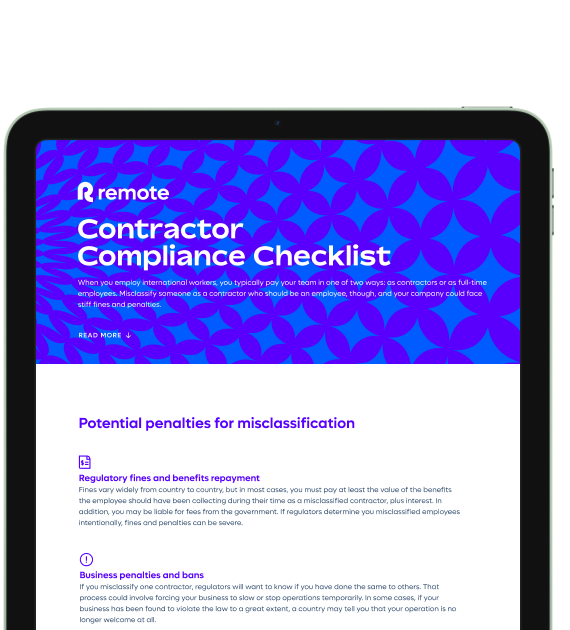
Remote & Async Work — 14 min

Contractor Management — 8 min
In the modern-day business landscape, it makes solid sense for companies to find top freelancer talent to work with. Compared to full-time employees, freelancers can offer businesses flexibility, diversity, and on-demand expertise as and when required. Rather than train staff (or hire new employees) to complete tasks outside their wheelhouse, companies can easily hire freelancers to work on part or all of the project.
That said, the process of hiring freelancers isn’t always straightforward. Finding the right freelance worker for the job, and then setting up procedures to onboard and pay them, can be challenging (and expensive). You’ll also have to be careful about avoiding the consequences of misclassification.
This article covers how to hire self-employed staff, the advantages of hiring freelancers for your core business, the difference between freelancers and contractors, and the best websites to source freelancers for your a-la-carte business needs. We also answer some of the most frequently asked questions about hiring freelancers.
Freelancing is on the rise globally. The World Bank estimates that freelancers make up 47% of the global workforce or roughly 1.57 billion people. The COVID-19 pandemic certainly helped catalyze this shift, though the so-called gig economy began much earlier.
For both companies and freelancers, the sheer growth in freelancing suggests that its advantages outweigh its drawbacks. Check out Remote's Global Freelancer Report below for insights on the benefits and challenges of freelance work.

Freelancers offer talent, expertise, and highly specific skill sets from a global pool. Having access to these professionals on a short-term basis can be game-changing for businesses of all sizes. Hiring freelancers allows you to maximize your capacity without draining your budget.
Hiring freelancers offers the following benefits:
Cost savings: A freelancing model leads to savings by limiting upfront and overhead labor costs. Companies don’t have to invest in training freelancers (costs that can reach $287,550 for an employee on a $135K salary), and as independent contractors, freelancers pay their own taxes and aren’t entitled to the same benefits as salaried employees.
Speed: Training or onboarding new employees is not just about cost — it takes time. Hiring a freelancer who already has the right skills for a limited-scope project often means your team can meet the deliverables more swiftly.
Expertise: Freelancers come with expertise on demand, often in a highly specialized niche. According to Fiverr, 81% of surveyed companies use freelance talent to fill skill gaps and support full-time employees.
Remote location: Freelancers work for themselves — and usually remotely. Companies aren’t required to invest in space, equipment, or other amenities for freelance workers.
Validation: Online freelancing websites come with built-in forms of verification for companies to conduct due diligence on potential freelancers. Before hiring a freelancer, companies can check reviews, work samples, and track records, ensuring a potential candidate is good at meeting deadlines and producing high-quality work.
Freelancers make sense for projects with a defined scope that demand a level of expertise staff members might not have. Self-employed workers can also free up your employees’ time so they can complete more high-level tasks. Website development, graphic design, content writing, and media production jobs are commonly sourced from freelance talent.
Freelancers aren’t employees, so managers who hire them need to remember that they aren’t their bosses. Like mercenaries in an army, freelancers are hired guns that come with an entirely different set of considerations than employees.
Relative to employees, freelancers have the following disadvantages:
Can be hard to monitor: Because freelancers work for themselves (i.e., they can have many clients at once), it can be difficult to track what they’re doing at any given time. If you prefer to manage your workers closely, working with freelancers might be challenging.
Can’t guarantee loyalty: Freelancers do their best work to make a name for themselves — not necessarily because they want what’s best for your brand. The freelancer who revamped your website is free to do the same for your competition (though non-disclosure agreements (NDAs) help safeguard your intellectual property).
Companies assume some risk for new freelancers: While it’s easier to vet a freelancer’s work history now than it was in the past, the reality is that working with anyone new carries a degree of risk. In terms of logistics and practicality, it’s harder to get an idea of how a freelancer halfway across the globe will perform compared to a candidate interviewing in your office.
Because freelancers typically have multiple clients, it’s best to avoid using them for long-term projects that require a vested interest in the company.
“Freelancer” and “contractor” are used loosely to mean the same thing: a person who works for a company for a defined period under a common agreement that determines payment, the scope of work, and other aspects of the working relationship.
Freelancers and contractors are not “employed” by the company (i.e., staff), but they might still work alongside employees on projects to achieve company goals.
A freelancer is an independent contractor who usually performs smaller pieces of work (like a website, logo design, or blog articles) within a shorter time frame.
According to Zippia, 32% of freelancers in the US define themselves as independent contractors. There is no hard-and-fast rule as to when a freelancer “becomes” a contractor, per se. When it comes to the tax code, they are classed together.
Misclassifying employees as contractors can pose legal and financial ramifications for businesses. The key differentiators involve control, independence, and the nature of the relationship as defined in the contract.
Misclassification can lead to penalties, back taxes, and lawsuits, so make sure you aren’t falling into this camp. In New York, for instance, businesses are liable to pay $2,000 for every 10 days of unpaid worker’s compensation from misclassified contractors.
Similar fines and penalties can arise when contracting internationally. Solutions like Remote’s contractor management platform allow businesses to hire and pay international contractors compliantly. Our team of global employment specialists has the local knowledge to make sure you aren’t misclassifying anyone on your team.

Freelance websites are the industry go-to for finding top freelance talent around the world. As many as 70% of all freelancers source the bulk of their client projects through these online platforms.
The following list of top freelance marketplaces includes a description of each platform along with its user base, common types of projects, and advantages and disadvantages.
Best for: High-growth companies that are looking to ramp up global hiring. Remote’s job board allows companies to post location-specific, geo-specific, or time-zone-specific contracts with pay ranges in any currency. Remote Talent streamlines the hiring process by helping you navigate the entire recruiting journey within a single platform — from posting job listings to hiring, managing, and paying employees.
Advantages: Current and transparent listing without ads, allows for team collaboration with full access to every job to view, edit, or delete job postings. Remote Talent also has remote-specific filters that help candidates see if the opportunity is a good fit before applying, leading to fewer irrelevant applications.
Disadvantages: ATS integration (in addition to Greenhouse) is in the works.
Best for: Companies that use multiple freelancers
A global platform with freelancers in fields ranging from web development to digital design, Upwork caters to both established businesses and newer startups. The platform is known for its global pool of talent and for maintaining transparency between contractors and employers.
Upwork handles contracting and payment on the platform itself, with 10% of each transaction charged to the freelancer and a $4.95 contract fee charged to clients on a per-contract basis.
Advantages: Time tracking; customer service
Disadvantages: Not all freelancers are vetted; limited dispute resolution
Best for: Smaller, finite projects
Getting its name from its low starting price point (creative tasks from $5 USD), Fiverr sets itself apart by offering a platform for businesses to source small-scale creative tasks with a quick turnaround. Think logo design, voiceover recordings, staff photoshoots, or company style guides. While this platform hosts a range of freelance skill sets, it skews toward creative and digital.
Fiverr charges a 5.5% service fee on all transactions, with an additional $2.50 small order fee for jobs under $75.
Advantages: No long-term contracts; low starting point for pricing ($5)
Disadvantages: Lack of dedicated account managers; marketplace freelancers aren’t vetted
Best for: Companies that want top-tier talent
Toptal positions itself as a freelancing platform with top-tier talent (“top talent” = Toptal). The platform targets larger enterprises as part of its client base and sources vetted, high-quality expertise through an extensive screening process.
The majority of Toptal freelancers fall within software development or digital design categories, with some expert writers, digital marketers, and even managers in the mix.
Toptal requires a $500 deposit to begin finding talent on the platform, and it charges clients based on hourly rates. Toptal is generally pricier than other freelance marketplaces.
Advantages: Highly vetted freelancers; candidate matching; time tracking
Disadvantages: Not advisable for short-term projects; few creative freelancers
Best for: International talent
Freelancer uses a competitive bidding system to match freelancers with jobs, making it suitable for both individuals and brands. Offering a wide spectrum of freelancers across various countries and industries, Freelancer is a great place to start for companies to see what’s possible with a freelancing strategy.
Freelancer charges a 10% fee on all hourly rates and 10% on all fixed-rate jobs (or a flat $5, whichever is greater).
Advantages: International talent; free support; custom milestones
Disadvantages: Limitations on dispute resolution; search feature can be hard to use
Best for: Hourly freelancers
PeoplePerHour connects businesses with international freelancers on a per-project or per-hour basis. Clients (businesses) can connect with freelancers in real time via the platform’s project management tool, payment gateway, and messaging system.
Freelancers in the marketplace cover a range of specialties, including content writing, voiceover recording, digital design, programming, business, and marketing.
PeoplePerHour receives service fees from freelancers (around 20%). There are also additional costs associated with posting urgent jobs or including NDAs.
Advantages: Easy-to-use platform; international talent; invoicing feature
Disadvantages: High cut of 15–30%; no customer service; no financial protection
Check out Remote's contractor management platform below to learn more about the best way to manage your contractors globally.
Sign up with Remote for locally compliant contract templates at just $29 per contractor per month, with no hidden fees.
Here are the answers to some of the most commonly asked questions about hiring freelancers:
Using freelancing platforms allows companies to hire freelancers compliantly. That said, these platforms take a percentage of each interaction to do so.
To enter into a legal working relationship with a freelancer, a company must:
Have a contract that details the work scope, SOPs, IP rights, etc.
Make timely payments
Classify these workers correctly (as contractors, not employees)
Local laws vary depending on where the freelancer is located, where your business is located, and where the work will be performed. Remote’s contractor compliance checklist can help you determine if your new hire should be classified as a contractor or an employee.
Because there are freelancers for almost everything (and they exist virtually everywhere on Earth), their hourly rates vary greatly. Software engineers, for instance, average higher than data entry specialists, and freelance digital marketers based in Sweden will cost more than they do in Jakarta (usually).
On average, however, the hourly rate for freelancers is $22/hr for females and $24/hr for males across all specialty areas.
Freelancers charge a higher hourly rate than their full-time employed counterparts because they a) don’t receive benefits, b) are responsible for paying their own taxes, and c) don’t receive overtime pay despite working the same hours as employed workers.
Yes and no.
For short-term projects, almost certainly yes because companies avoid the onboarding, training, and other up-front costs normally associated with new hires. Freelancers are responsible for their own equipment (computers, software, supplies) and office space as well.
Hourly employees might cost less than freelancers in terms of wages alone, but the cumulative value of their benefits (paid time off, sick leave, holiday pay, health insurance) might serve to tip the scales.
In any freelance or contract arrangement, a contract protects both the company and the freelancer. It should detail the scope of work, the amount to be paid, the payment process, and any limitations to protect intellectual property ownership.
Remote helps brands generate contracts that abide by local laws and compliance regulations.
Most businesses would agree: finding a freelancer to handle concrete tasks or projects not in your company’s wheelhouse makes for a good business move. While a freelancer’s hourly pay may be higher than the average employee’s, it can make more financial sense because the company doesn’t need to invest in training, day-to-day management, or benefits for that individual.
Managing a global team of remote freelancers, however, brings unique challenges. From misclassification risks to managing contractor payments compliantly and on time, having a solid system in place to streamline the process can help you stay on top of the moving parts. Remote’s contractor management platform helps you save time on admin work by helping you onboard contractors, manage payments and invoices, and organize tax forms, in one place.
Hiring freelancers around the world becomes simple with Remote’s contractor management platform. Try Remote for free to start hiring, managing, and paying freelancers compliantly.
Work through this checklist to help determine if a new hire should have a contractor or employee relationship.

Subscribe to receive the latest
Remote blog posts and updates in your inbox.